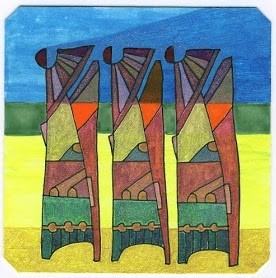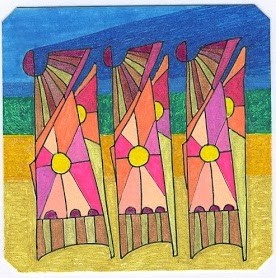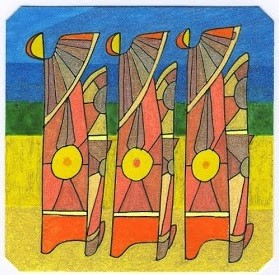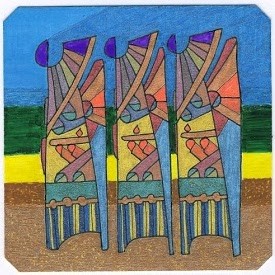
For those of us who write, it is necessary to scrutinize not only the truth of what we speak, but the truth of that language by which we speak it. For others, it is to share and spread also those words that are meaningful to us. But primarily for us all, it is necessary to teach by living and speaking those truths which we believe and know beyond understanding.
―Audre Lorde
You think your pain and your heartbreak are unprecedented in the history of the world, but then you read. It was books that taught me that the things that tormented me most were the very things that connected me with all the people who were alive, who had ever been alive.
―James Baldwin
There is a garden in me.
—Fertile Ground
To begin. A parable.
When she was a child, her mother dressed her for outside using her own inner thermostat. The mother’s temperature gauge was a fine instrument. The mother’s name meant green and the mother had a green thumb and the mother’s body was photosensitive and sensitive to cold. In winter, the child became a tight bundle of blue, soft and warm, mittens, scarf, hat, and hood, layered and wrapped, zippered and snapped. Blue sunshine waddling to the car. And since her bedroom was the hottest in the house, perched as it was directly above the furnace, she came to associate heat with safety and the mother’s care.
With the light, there is also heat and fear.
It was a bud of narrative, something that translated into Mommies can be stolen and made dead, taken away to heaven and never seen again. The idea of death stealing her mother became a torment for the child who started dreaming each night of a corpse in her bedroom closet. A grey paper mother tucked in dried baby’s breath. Though it made the room even hotter, the child shut the closet door each night to trap the mother-faced paper woman in the narrow dark at the foot of her bed.
To begin. Making in the light.
I have been the child. I become the poet.
After I rendered memory, invented memory, and desire in poetry, I was able to leave the narrative go for a time. And for a time, the child retreated into a past and the terror lulled. And a different narrative sprouted from the seed.
As a child of nine or so I wrote a poem about gluttony, one of the few I still remember. It went something like:
Cookies, candies, cakes, and pies!
Oh! What treats before my eyes!
If I eat them I’ll get fatter.
What’s the difference? Does it matter?
Mother calls: Go clean your room!
My feast shall be on salted broom.
Perhaps I was re-imagining a restaurant desert tray or display case, or an amusement park confectionery, or Willy Wonka’s scrumpdidilyumptious chocolate factory! I remember thinking myself clever because of the detail I invented for the rhyme (my bedroom carpet was wall to wall), never mind that the entire scenario had been made up.
As happened often in life, in the poem, my childhood ruminations were interrupted by someone else’s plan for that moment. A small chore—aka, my contribution to the collective work and shared responsibility of being family together.
Like many children, I wrote poems for fun, to play with words and their assorted materials, to bend and twist them like pipe cleaners, and to document and make (non)sense of curiosities, confusion, and distress—mine, what I witnessed second-hand of my playmates experiences at school, and what I encountered through others’ stories, books, and films. When I was nine or ten years old, I wrote a poem called “The Streets.” A budding poet, I tore it out of my spiral notebook, took it to a friend’s house to share and promptly lost it. I remember now its figment because I tried to recreate its lines but could never quite recall the lost thing that in absence of memory became so perfectly crafted. The poem listed main drags on Chicago’s South Side—hotspots I had only been driven past in the car—and paired those storied streets with action verbs in sharp staccato bursts punctuated by symbols of urban decay. At the end it circled back round, tidy, to the title. It was a fifth grader’s echo of Margaret Walker Alexander’s stately “For My People” and hip BAM vernacular raps.
My head was full of poems, songs, and rhymes. I had my favorites. From almost naughty playground-meet-school-bus-songs like “Old Hogan’s Goat” (a jazzy version of the traditional folk song “Bill Grogan’s Goat,” complete with the headless goat meeting St. Peter in heaven) to quartet gospel renditions of coded spirituals like the Swan Silvertones singing “Mary Don’t You Weep” (1959), and rousing Black marching chants like “They Keep Coming” (click on the image to play below) from the original cast recording of Micki Grant and Vinnette Carroll's Broadway running musical review Don’t Bother Me, I Can’t Cope (1973).
Many of my favorite poems came from Arnold Adoff’s I Am the Darker Brother: An Anthology of Modern Poems by Negro Americans (1968) and other books my mother shared with her students, my older siblings, and me. And there were recordings of poets reading and performing, too.
These poems reinforced my parents’ lessons, my communities’ hopes for me—for us. Among other things, they were my armor and my shield.
In the girlhood becoming woman?
I repeated the verses of these poems to myself quite often:
The first stanza of Margaret Burroughs’s “What Shall I Tell My Children Who Are Black.”
What shall I tell my children who are black
Of what it means to be a captive in this dark skin
What shall I tell my dear one, fruit of my womb,
Of how beautiful they are when everywhere they turn
They are faced with abhorrence of everything that is black.
Villains are black with black hearts.
A black cow gives no milk. A black hen lays no eggs.
Bad news comes bordered in black, black is evil
And evil is black and devils' food is black…
One of the last stanzas of Gwendolyn Brooks’s “Primer for Blacks.”
The huge, the pungent object of our prime out-ride
is to Comprehend,
to salute and to Love the fact that we are Black,
which is our “ultimate Reality,”
which is the lone ground
from which our meaningful metamorphosis,
from which our prosperous staccato,
group or individual, can rise.
The first two stanzas of Paul Laurence Dunbar’s “We Wear the Mask.”
We wear the mask that grins and lies,
It hides our cheeks and shades our eyes,—
This debt we pay to human guile;
With torn and bleeding hearts we smile,
And mouth with myriad subtleties.
Why should the world be over-wise,
In counting all our tears and sighs?
Nay, let them only see us, while
We wear the mask.
Saying them aloud to myself as I typed them, I felt the curves and edges of their phrasings in my mouth, in my chest, reveling in their pinpoint accuracy. Gems from the childhood and the girlhood in the perfect arrangement of thought and feeling. They were my companions. And through them I inherited a luxurious and meaningful relationship with language and a sense of connection, a strong social element, like a tether to the world of the living (even as the verses were sometimes the words of the dead). Those poems permeated the isolation and alienation I daily experienced growing into myself to foster a sense of belonging.
It is okay, I learned (and continue learning), to start again. Time after time. It is good. It is like drinking water, someone said. This process is, for me, an art practice, a life practice. It is the root of poetry, its seed, and flower.
While writing this essay, I searched online for the phrase “light of death” and found a book described as engaging a Buddhist text known as the Five Subjects for Frequent Recollection. The book, called Living in the Light of Death, is said to examine the “lifelong companion” of Death as one of four messengers: Aging, Illness, Death, and the Inheritance of Our Actions. Having only glimpsed inside, I pondered its provocative argument. If these be the messengers, what is the message?
Death is our common name.
How intimate the connection for you to answer to it, to receive its call, for you to encounter it and call it yours. There is a Yorùbá proverb that reads: Ikú lorúko̩ àjé̩pè̩kun, literally translated as “Death is the name one bears at the last,” or more figuratively, “Death is the ultimate fate for all.” I have only recently come to accept the fact of death: that none living can escape. I do not like it entirely but as I have grown more accustomed (though still resistant) to my inability to control what will befall me and those I love, I have come to appreciate this certainty. It is a relief. Heretofore I have exhausted myself trying to prepare, to thwart the devastation of the impending loss of those I hold dear, my blood and chosen kin. Until, one morning, I emerged on an other side of grief to experience this certainty as an epiphany, an effulgence akin to a flood of resplendent light: There is nothing to be done. It has long been decided. Even as the nitrogen, calcium, iron, and carbon of us were made in the interiors of collapsing stars. Death and life cycle perpetually, ubiquitously, symbionts. Together, being. My charge, being, is some other thing. And I am free.
The generosity that the light of death bestows, illuminates a former self. It burns off the fog of grief and dispossession to reveal the illusory quality of the absolutes by which I had been judging my life and the value of being, the value of poetry in U.S. capitalist material culture. It transforms my way of thinking of relationship, of relation, to compel a paradigm shift.
In the light of death, poetry again becomes sustenance—a vehicle for self-transformation and fulfillment, for understanding our common humanness, for a daily practice of meaning-making through shared encounter—as much listening as making. The gestalt. Sound and sense and movement and mouthfeel.
When I was a child becoming girl becoming woman, being queer Black often gender-slippery woman body in pain, moving without literary aspiration or knowledge of the market, poems were like bread, milk, and meat—were sustento: the most basic sustenance. I read voraciously and kept what fed me, what I needed to keep living. Poems weren’t for school. They weren’t for status or the dance of a solitary intellect. They weren’t for show. They.were.for.my.life.
In that time and in the light of death there is a generosity, forgiveness, and urgency: I hear Ntozake Shange’s refrain: “whatever good there is to get / get it & feel good.”
Tell the truth; leave signs.
In college, I covered my pink, lavender, and blue copy of Cheryl Clarke’s Living as a Lesbian (1986) with blank white paper to avoid scrutiny and conversation. I wanted the world of those rhythms to myself to move toward understanding what I seemed to be learning about myself in an encounter with the work. The poems that stayed with me most? “Living as a Lesbian Underground: A Futuristic Fantasy” (“leave signs of struggle”) and “Sister of Famous Artist Brother.” I performed the latter in a cabaret-style play, put on by Heritage Theatre Ensemble, our Black undergraduate dramatic association. I was 18.
I want to read it you. And with it, Judy Grahn’s epic “A Woman is Talking to Death.” (1974) And Shange’s “About Atlanta” from A Daughter’s Geography (1983)—a poem that gave me words for the terror the Atlanta child murders provoked as I caught the bus to school so many miles away in Chicago.
And now I think to close with the last stanza of Ntozake Shange’s “Hijo de las Americas” (A Daughter’s Geography, 1983):
i must remember to remind my poet friends in America /
to keep matches in their houses/ i must remember that
everywhere
nothing can be taken for granted/
not yr thoughts. not yr beliefs.
they go with you/
or you burn them behind you/
Criminal/ huh? to watch fire eat love of what you come from/
what you want/ Necessary for the children/
we can always remember/ but if we burn with the poems/ who
shall tell the children/ why
el salvador
Carrying a clipboard and sheaf of cotton paper, I went out to the lake, to the beach park across from my house to write. I sat in a favorite spot, a solitary concrete block jutting out over the sand. Finding no pen, I typed a few notes into my phone. Mostly, I sat feeling the cool spring breeze, listening to the waves break against the rocks, watching the lake shimmer as a woman and her two small dogs high-stepped through the sand toward the grass and a boy played alone by the pier’s far north wall, batting stones into the water with a big stick. I looked down to type then looked up to see the boy had tied his jacket around his waist with its sleeves. Flapping behind him, his jacket was as blue as the water. And as he turned, it seemed to spin the sun’s reflection into iridescence.
Against the light, I watched the gulls circling and diving: one, then two, then four skybirds, as I measured my slowing breath. Resting my forearms on my knees, brushing the sand from my ankles and heels, I thought nothing. There was a shift in kinesthetic awareness: My mind was a wordless current, a vibration. Rising, I felt a particular bodily sense of rightness, cenesthesia; I felt my aliveness, its blue water, a corolla opening, its interior brought forth glowing into day. In the vibrant air, my aliveness seemed to be evidence of presence amplified in all that surrounded me.
And these words are placeholders through which I return to illumination, to re-emerge, and there, in the light of death and its depth of field, what was made known (though it yet resists articulation), I can best describe as an enduring substance, akin to the personage of being.
Enacting poetic activity/poetry making with a goal of reciprocation, the poet aims to make her sentience (the energy transfer of projective verse) shareable and to alter/impact the sentience, the living being of self and others (her audience: you and me). The poem, as made object, Elaine Scarry writes in The Body in Pain, is “a lever across which the force of creation moves back onto the human site and remakes the makers.” For, significantly, as Scarry notes quite specifically, “The poet is working not to make the artifact (which is just the midpoint in the total action), but to remake human sentience; by means of the poem, he or she enters into and in some way alters the alive percipience of other persons.”
The body is always making, beneath the level of consciousness, the systems in close proximity and intertwined. Multitudes in the cell, corridors, theaters of bacteria, flesh, bone, and blood. And more. The body, a coalition of interdependent systems, making, embracing impermanence and then? There are many things I know I do not know.
Some time ago, in the poem “Living Body,” I wrote: “I don’t want this/ body. The body wants me.” (Drag, 2003)
One thing I was referencing was the way it seemed that my body willed itself through the perpetual present, always being alive. I would awaken surprised to learn that I had not died during the night. Because I felt nothing. Attached to/ invested in neither living nor dying. Either seemed like more commitment than I could muster, more presence, more feeling. I was in a nonspace. I was a nonspace, it seemed. I do recognize that everything I am writing here, I am writing from the vantage point of being a living human being tethered to life in a human body no matter the degree to which or the frequency with which my mind has shut off the stimulus of embodiment to preserve some degree of integrity.
Being, my body/my self has known what to do in the face of a threat she could not manage, hardwired for survival and functional, she/it/my body-self has kept me/us alive and safe so we/I could continue toward the possibility of recovery and unhampered embodiment out of reach of danger.
In retrospect, when I am fully present, in making language, in meditative action, in imagining, in physical or creative play, or just being, there is relief—a type of freedom. Other times, like when I am in the throes of (physical or psychic) pain, I am so anchored in my flesh and its distress, so radically embodied, that my consciousness is nearly obliterated.
When I emerge into making from dissociation or vacating prompted by threat, it is as emerging into the light of death, waking into presence with a sudden exceptional coordination of attention, sentience, and percipience.
The wound is the place where the light enters you.
—Rumi
In the United States of America—a republic with a long, varied, and vigorous history of state-sanctioned violence and suppression—Black expressive arts and cultural practices have traditionally functioned as ritual intervention. Embodying strategies of resistance, this intervention—this innovation—enabled the survival and relative prosperity of various individuals and communities of Black peoples beset by hostility, duplicity, systemic racism, and terror. And always on the horizon the threatening and very real prospects of abject poverty and torture, rape, and murder at the hands, guns, and ropes of whites, from the solitary joy rider to the passing mob: strangers, classmates, betterment leagues, elected officials, the law. The gamut. Gloves off—hoods on. Hoods off—studies, campaigns, and policies on. Living in this socio-historical moment, as an artist, writer, and creative intellect committed to social justice and envisioning the full realization of our collective humanness, this legacy of the resilience, resistance, and innovation of Black folks and our allies continues to inspire me.
Lest anyone be caught unaware,
I am unavoidably, inalterably, unashamedly Black, unapologetically queer, curiously gendered.
My disability is variably hidden.
In the threshold, moving among and between borders I do not cease to be a target.
Still I am relatively well resourced. I can shop at Whole Paycheck to work around my food allergies. I have health insurance. Vision. Dental. Documents. Therapies. Degrees. Choices.
And in the thick of it I have theoretical frameworks with which to analyze and contextualize.
Multiple jeopardies. Categories and hierarchies of difference.
Productive forces of power and domination.
Toward resisting terror, binary tyranny, artifice, hubris, lack.
Toward inhabiting the fullness of being.
Even as resistance is necessary, and mine can be said to be, by and large, an oppositional poetics, I am disinclined to permit space (here or in my mind/body/self) to discuss the details of false meta/narratives, and official discourses, and the dossiers of disinformation disseminated by/in support of (fascist) white supremacist patriarchs, matriarchs, their agents, progeny, and/or constituents.
Neither they, nor their poetry, have celebrated my survival.
And so often the rule of law is/has been written, applied, or broken at their discretion.
A right to remain silent in one context, does not equate to an advantage in another.
The master’s tools, the master’s house, etc.
Here, let us take respite from the dizzying bait and switch of the current (social) media circus, from the blight, from the white supremacist imaginary. And begin again.
To dive into the mouth of it.
To draw breath and live well.
Death is our common name.
Power, our common birthright.
Duriel E. Harris is a poet, performer, and sound artist. She is author of the poetry collections No ...
Read Full Biography





